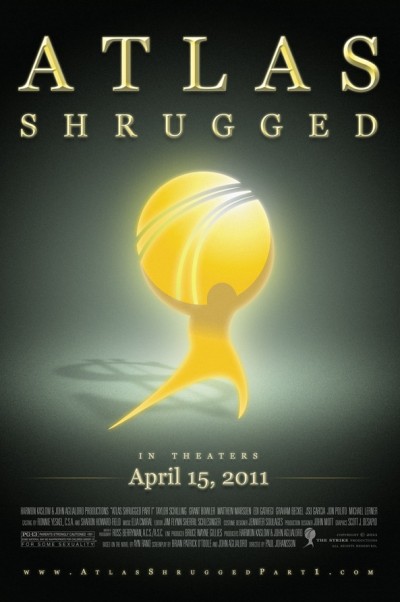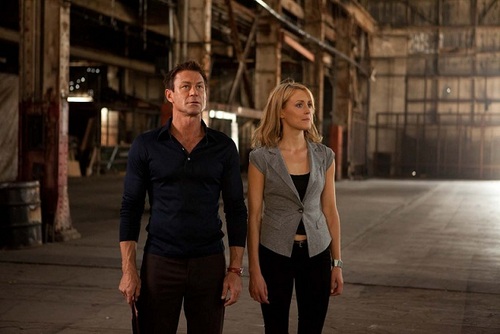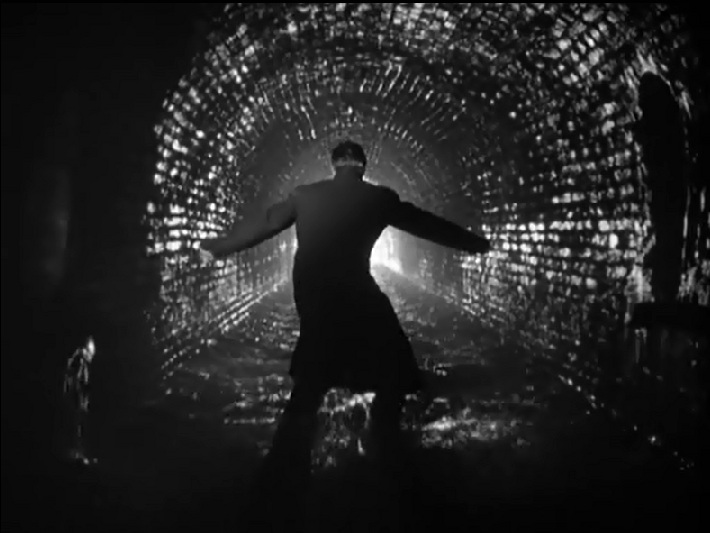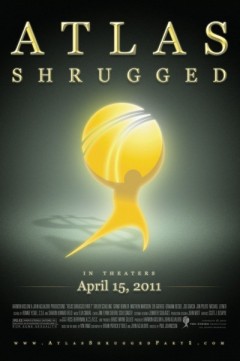 In Ayn Rand’s novel Atlas Shrugged, the first time we meet Dagny Taggart is on the Taggart Comet. The scene comes alive as Rand’s pen reveals the details such that the reader feels as if he is there. When Dagny awakens from a nap to discover the train has stopped, she gets off to investigate. Ayn Rand writes:
In Ayn Rand’s novel Atlas Shrugged, the first time we meet Dagny Taggart is on the Taggart Comet. The scene comes alive as Rand’s pen reveals the details such that the reader feels as if he is there. When Dagny awakens from a nap to discover the train has stopped, she gets off to investigate. Ayn Rand writes:
There was a cold wind outside, and an empty stretch of land under an empty sky. She heard weeds rustling in the darkness. Far ahead, she saw figures of men standing by the engine—and above them, hanging detached in the sky, the red light of a signal.
I have often thought Rand would have made an excellent director, and in that single paragraph we can see some of her talent. She appeals to three senses and evokes compelling images in our heads. A director, location scout, sound engineer, set designer, and cinematographer intent on filming such a scene have half their work done for them already. Let us hear the weeds but not see them; let us see Dagny shiver once and hold her coat tighter to her body; let us see a long shot of silhouettes of men bathed in red light from the stoplight that seems to float in the dark sky above them. The appropriate shots present themselves, practically instructing the director.
Before the stop, Dagny hears a brakeman whistling a tune she just knows was composed by Richard Halley.
“Tell me please what are you whistling?”
…“It’s the Halley Concerto,” he answered, smiling.
“Which one?”
“The Fifth.”
She let a moment pass before she said slowly and very carefully, “Richard Halley wrote only four concertos.”
The boy’s smile vanished… “Yes, of course,” he said. “I’m wrong. I made a mistake.”
This early scene, which I find excellent and a great mood setter for the rest of the book, is absent from the movie. So too is any trace of the talent for storytelling present in it.
The entire bit about Richard Halley has been excised, to the film’s detriment. It’s a great way to introduce the mystery of unexplained disappearances and its recurrence reinforces the theme, but in the effort to reduce over 300 pages of small print to under two hours of running time — yes, you read that correctly — it was picked for cutting. If they were short on funds, which reportedly they were, and did not want to hire a first class composer, could they not have used a piece by Rachmaninoff and pretended? It’s not as if more than one American in a thousand would have noticed.
When a novel becomes a movie, unless it is a very short novel, there is always going to be some abridging; in a novel the length of Atlas Shrugged, even when divided into three parts, the expurgation is going to be, in proportion to what makes the final cut, the submerged part of the iceberg. A running time of just over a hundred minutes exacerbates the problem. Themes that Ayn Rand developed over time, like a chef who slow-cooks a rich stew, are flash-fried now. For instance, in the book, d’Anconia’s scheme with the Mexican mines serves to point out the inconsistency in men like Jim Taggart, who should have approved of what he did to be consistent. In the movie, this point is nearly lost. Dialogue can no longer be organic and evolve naturally, because chunks of statements from other sequences must now be inserted into foreign scenes, forced into them, and feel about as natural as you would expect. There are times when a character will say something that is obviously a set for another character to spike, but we get no satisfaction from it because it feels awkward.
If what remains in the film is rough, that which is absent is sorely missed. If one did not know the extent to which the story was condensed, one would think that the entirety of Part I of Atlas Shrugged consisted of businessmen and women sitting at mahogany tables and plotting to ruin competitors and/or make money. ‘Tis no such matter, but the movie concerns itself with little other than these scenes, which gives much the same impression as a pianist who will only play one note. A man can grow awfully tired of hearing the same note over and again.
Despite all the cutting that was done to the story, the screenwriting is poor enough that time and space were found to waste with unnecessary repetition. When Dagny Taggart hits upon the idea of opening her own rail line, her brother asks her what she is going to call it. There is a pause that is meant to be dramatic, and then she turns and announces, “The John Galt Line!” In the very next scene, she tells Hank Rearden she is going to open her own rail line and he asks her what she is going to call it. There is a pause that is meant to be dramatic, and then she turns and announces, “The John Galt Line!” Here’s a better idea: put all the unused scenes not featuring business discussions in a hat, draw one out and include it somewhere in the screenplay. Anything to break up the tedium.

We can be sympathetic to a screenwriter, even while we skewer him, when he has such an admittedly difficult task. Nevertheless, the incredible complexity and difficulty of a jump does not make it any less of a disaster when the figure skater smashes her face on the ice. I suppose the screenwriter in this case can take some consolation knowing the editor and director must take their turns at the whipping post and give misery the company for which it yearns.
I do not recall ever seeing a more lifeless piece of editing. So relentlessly dull and implacably devoid of excitement is it that any sort of climactic scene — say, when Dagny and Hank make the first train trip over rails of Rearden Steel — is a completely unexpected surprise, even for one who knows it has to be coming sometime. I say surprise, but not enough of one to speed up your heart rate. When Dagny is scrambling for funds, each scene is presented in the same, methodical, insipid way. The same is true for any presentation of work being done on the line. There is no up swell in pacing, cutting, rhythm, camera movement, urgency of acting… nothing at all. The line is just suddenly finished, crescendos be damned. But there is a musical score instructing us to feel some tension and exhilaration.
Let us not forget the director, who brings all of the artistry of a soap opera to a motion picture. The monotony of so many similar scenes simply screams out for some ingenuity in direction, blocking, and camera-work; some sort of change of angle, approach, or perspective. We get nothing. Two characters face each other over a table and recite lines while the editor cuts between master shot and over-the-shoulder shots. A sixth grader would do no worse. The same lack of movement, tension, and development in the film characterizes the individual scenes as well. And the end of one scene just means the beginning of another of the same ilk. There is no clever use of a prop to make a scene stand out, no creative blocking and certainly nothing one could call inventive use of a camera. For purposes of comparison, I give you a screen shot from Atlas Shrugged, which is perfectly representative of the kind of photography the movie gives you, and a shot from The Third Man. Judge for yourself what is flat and what is dynamic to the eye.


We might mention one more poor decision before we drop the whip and leave the dead horse alone. In addition to removing the part about Richard Halley, the filmmakers have also taken the bite out of the central mystery of the plot, which is the disappearance of industrialists and first-rate men and women. In the novel the mystery is unsettling; in the movie it is as dull as anything else, but this might have been improved if they had shown us less. I recall a scene in the book where Dagny sits outside someone’s office while John Galt is inside, recruiting yet another striker. Dagny desperately wants to barge in but her honor code won’t let her, so she waits her turn and, when she finally enters, discovers she has lost another and still has no idea why. We see very little, and up to that point we had seen even less.
There is no such gripping scene in the film, and we see far too much of Galt’s recruiting process. We even are told, through his dialogue, why he is recruiting them and are given a good idea of where they are going. I am mystified by such incompetence. I have a two-year-old who, when he plays hide and seek, never fails to tell me exactly where he is going to be hiding. Paul Johansson manages only a little more restraint. Did he read the novel and think it was too exciting, that movie-goers should not be too intrigued by a mystery?
As a final act of overindulgence, when Wyatt’s factory is found in flames — the scene that ends Part I in both novel and film — the director even here cannot leave well enough alone. The book ends with the words Wyatt posted at the foot of the hill: “I’m leaving it as I found it. Take over. It’s yours.” In the movie, we see the post with Wyatt’s words and Dagny is in the background, agonizing over the fiery destruction before her. It is the closest the movie ever comes to being captivating, but instead of just ending at what passes for the flick’s best moment, we must endure a voice-over of the actor who portrays Ellis Wyatt explaining what we already understand. He ends with, “I’m going on strike!”
We could criticize more — the acting comes to mind — but why bother? Though there is plenty more to disparage, there is not enough wrong with it to at least be unintentionally funny. The movie is bland, and the blandness denies it the heaven of Rear Window as much as the hell of Plan Nine from Outer Space. It is purgatory, and the novel deserved a lot better than that. Now, all the know-nothing detractors who claim the story is bad have been given a generous stockpile of ammunition and we are going to have to endure their assault for some time.
I can think of only one conceivable positive to take away from all this, and I shall mention it for those of you mean-spirited enough to revel in it: the problems with the movie derive in part from the fact that the man who owned the rights to the story was nearing the end of his term and so threw the movie together before his rights expired. Intellectual property — that foe of artistic creativity, which had a friend in Ayn Rand — has played a role in diminishing her work as it went to the silver screen. Make of that what you will; I merely point it out and pass on.
















Comments on this entry are closed.
MG March 27, 2012 @ 4:16 pm | Link
Rand did indeed write with movies in mind. If you will notice Fountainhead book ends in two complimentary scenes of Roark. A lot of money shots vanished ; We The Living did better.
AS is a scriptwriter’s and budget dream but, as she said, would take a movie series of 10 films to do properly. I think that is doable; believe they wasted money in nedless effects in the first one: this is a natural low-budget drawing room film/s for most of it. One needs to use and have respect for the material, especially when Rand made it easy to do more with less.
That said, I think it was good– and can get better– given what they tried to do. In truth 99% of literature and major histoical events await a movie and most movie attempts on those themes suffer from similar problems: re-doing what is already dramatic and not following the organic story.
Matthew Alexander March 30, 2012 @ 10:10 pm | Link
I definitely think this would be better as a mini-series, or even a full length series. We shall see what is in store for us.
Thanks for stopping by!